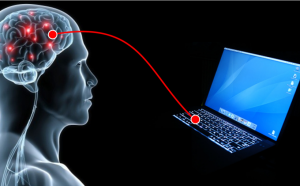Can you make your brain wave?

Some technologies start off as science-fiction, as they are often difficult to visualize and difficult to execute. Space travel and rocket ships started out this way, like so many innovations over the past 100 years. Medical technology also has made great strides that were unimaginable just a few years or decades ago.
One of the concepts trying to cross the line to reality is the ability to link the human brain to a digital computer, a concept that Elon Musk has termed the Brain-Computer Interface (BCI). This radical concept has been around for almost 50 years, as research was conducted in the 1970’s at UCLA, funded by DARPA (US military) and The National Science Foundation. This early research was conceptual, producing no working models. Today we have relatively crude communication with the human brain via EEG’s, which sense and record brain wave patterns using an array of electrodes on the scalp. The interesting observation is that the neurons of the human brain use the same power source as digital devices like computers – electricity. So – why not develop ways for electro-fired neurons in the brain to communicate with electro-fired transistors in digital devices? We can now envision a BCI with some very useful applications, such as allowing amputees to have control over robotic arms and legs by just using their minds.
The technology is based on electrical impulses, as the brain sends and receives messages through the body’s nervous system. Nerve cells (neurons) receive and pass along these electrochemical pulses back and forth throughout the body. These cells operate on an all-or-nothing condition – they are either on or off, and this is eerily similar to the way transistors in a computer’s integrated circuit operate. This comparison is very simplistic, and we cannot say that the brain uses conventional binary logic exactly like a computer, but neurons do rely on the all-or-nothing state to function. Each and every sense, muscle movement, feeling, and thought is a result of the electro-firing of neurons in the body.
Capturing neuron activity, and doing so quickly and at a high resolution, is the key to getting the data required to eventually decode the true and complete messages the neurons are sending along. Once we have the decoded messages we can pass them along to a digital device, such as a computer or robotic arm. We are a long way from having a functioning, practical, and useful BCI, but there is progress being made by several technology companies to develop ways to better detect and capture neuron activity. Currently, there are inventions being developed that will capture much more neuron activity than the external electrodes now in use, such as thin-layer implants that can insert an electrode “sheet” directly on the brain. Imagine the day when we can simply think about waving a robot’s hand, and that brain wave will actually cause the robotic hand to wave. This still sounds a bit like science fiction, but now we can visualize some of the very useful and helpful things that could be done.
Technologies like this bring about a number of ethical concerns and a question, as is the case with many of the new medical innovations, but the human mind is a very powerful thing, and also a very curious thing. Who is to say where the boundaries of our curiosity should be set? Can we now imagine all the experts, theologians, and politicians who will try to get it right – let’s give them all a wave.
Check out this video showing how a monkey was able to control a robotic arm with its brainwaves to eat marshmallows.
Trend Disruptors is monitoring these developments, and will recommend companies to invest in that will lead to success for the well informed investor.
Stay tuned!
